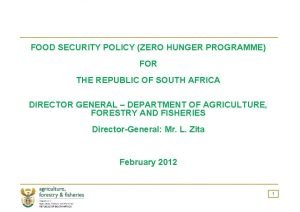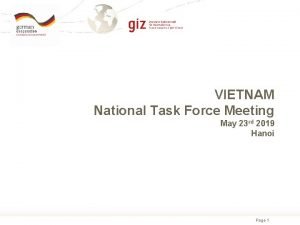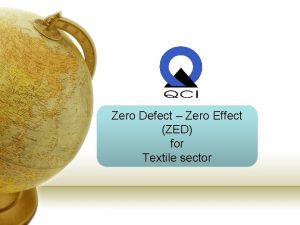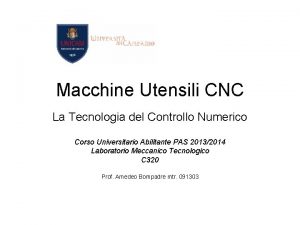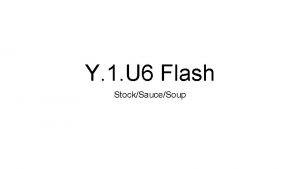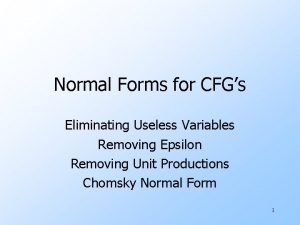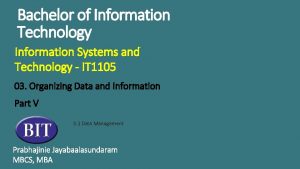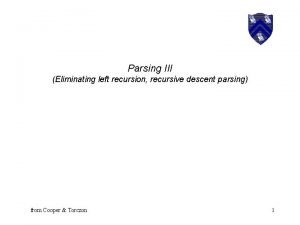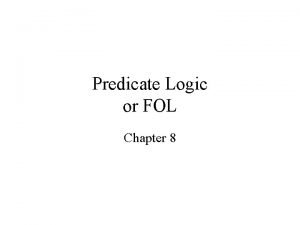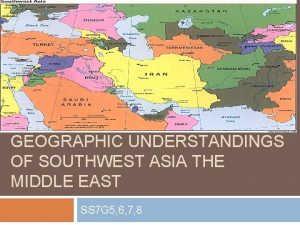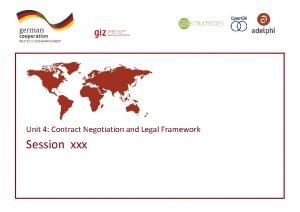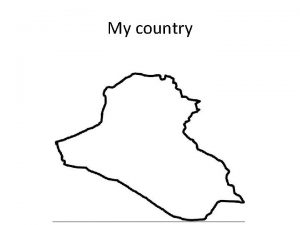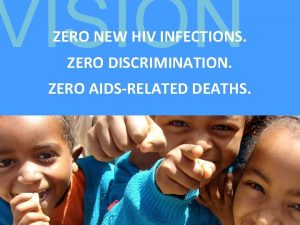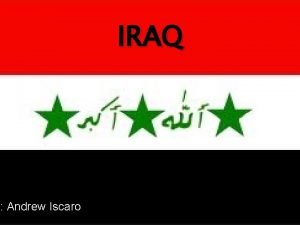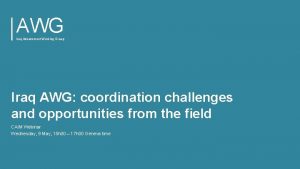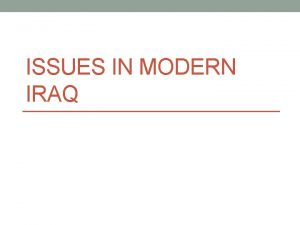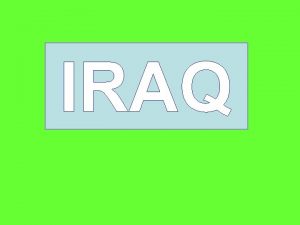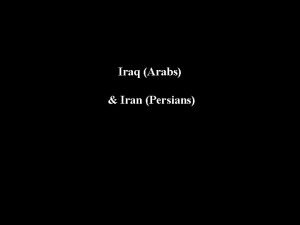IRAQ Zero Hunger Strategic Review Eliminating Hunger in

















- Slides: 17

IRAQ – Zero Hunger Strategic Review Eliminating Hunger in Iraq and Meeting SDG 2 Targets Presentation of Preliminary Results WFP IRAQ - ICARDA Consultative Workshop Meeting 28 March 2018, Baghdad, Iraq Boubaker Dhehibi (on behalf of ICARDA Team) SIRPSP/AMMAN-JORDAN b. dhehibi@cgiar. org Baghdad, Iraq| 28/03/2018

Objectives of the Review – A Reminder The overall objective of the Review are: ⦿ To prioritize actions that will be required to accelerate progress toward ensuring food security and enhanced nutrition and in-line with SDG 2. ⦿ Specific objectives will be as follows: ⦿ Undertake a comprehensive analysis of current food security, nutrition situation, and agricultural sustainability against targets of SDG 2. ⦿ Review current policies which are being considered and undertaken in Iraq for eradicating hunger; ⦿ Identify the required policy and institutional gaps, as well as resources needed, to achievement SDG 2 objectives

Food and Nutrition Security in Iraq: The current situation ⦿ HDI: 0. 57 (1996) to 0. 65 (2015) – Iraq: 121 (out of 188 countries) ⦿ GDP per capita: increase for an average of 4% per year: USD 4. 098 (2007) to USD 5. 695 (2016) ⦿ Average dietary supply: 110% ; Average protein supply: 65 gr/capita/day (2014 -2016) ⦿ # Undernourished people: 6. 5 M (2002) to 10. 1 M (2016) ⦿ CFSVA (2016): 17% of children are stunned & Low birth weight: 13% ⦿Nutritional Strategy: High level of illness among women and children: ⦿ Anemia among childbearing women (15 -49 years): 35. 5% ⦿ Anemia among children (<5 years): 26. 2 % ⦿ Vitamin A deficiency among pre-school children: 13. 8 % ⦿ Obesity: 20% of adults are obese (Females: 38%; Males: 23. 4%; Adolescents: 8%) ⦿ Between 1997 -2016: Male obesity rate grew from 14 to 23% !!

Factors Driving Food and Nutrition Insecurity in Iraq Poverty: ⦿ 22. 5% Iraqis live below the national poverty line (IRD 105000 – USD 84/month) / ISI-affected Governorates: Poverty rate is above 40% ⦿ CFSVA(2016): 53% of the population is vulnerable to food insecurity Low rural productivity and incomes: ⦿ 30% of population are living in rural areas (50% of the poor living in rural areas) ⦿ Poor agriculture yield (Cereals: 2 T/ha): Lack of infrastructure; decreasing water supplies; increasing land degradation and fragmentation; poor marketing channels, etc. ⦿ Limited opportunities for off-farm employment (lack of processing, transport and storage activities) ⦿ Widespread Government intervention: (private sector uncompetitive + subsidies – wheat sector) Gender inequality and gender inequity: ⦿ Low literacy rates for women / Lack of empowerment (Large family sizes) ⦿ High economic dependency rates (1 working person is supporting 6 people) High unemployment rates: ⦿ High unemployment rates among youth: 35% ⦿ Inefficient cash transfer programs for the poor (43% of beneficiaries are not poor) + Disparities in income distribution (Poorest quintile 7% of income – Richest quintile 39% of income) ⦿ Lack of livelihoods and chronic poverty among IDP’s

KEY ACTION AREAS FOR THE ACHIEVING SDG 2

Action I: Improving Safety Net Instruments – The PDS System Past Trends ⦿ PDS is covering almost the entire Iraqi Population (Fiscal cost is large) ⦿ The size of PDS is so large that it has major effects on Iraqi economy (allocation of resources within the country) ⦿ The PDS has distortionary effects on the structure of domestic food market prices ⦿ Large variations and decreases in funding (Share from the government budget: 4. 99% in 2010 to 1. 68%, in 2017) Current Status and Issues ⦿ High costs of logistics ⦿ Inability to meet commitments. Inefficiently accomplished role because of the absence of targeting ⦿ Strong willingness to make the system more effective and efficient Needs & Priorities ⦿ This programme need to be made: ⦿ More effective and efficient with a much improved targeting (perfect targeting) ⦿ Cost effectiveness and monitoring systems ⦿ Leadership, accountability and setting priorities

Action I: Improving Safety Net Instruments – The PDS System Proposed Interventions: Options For Reforming PDS ⦿ OPTION I: Move from universal in-kind PDS to universal Coupon (ALL) ⦿ OPTION II: Move from universal in-kind to targeted Coupon (ALL) ⦿ OPTION III: The PDS delivery is changed from universal in-kind to universal cash (ALL) ⦿ OPTION IV: Move from universal in-kind to universal targeted cash (ALL) Note: For geographically Targeted: Possibilities to select to optimal combination between In-Kind, Coupon and Cash. Proposed Interventions: Options For Reforming PDS - Perfect Targeted” (ONLY POOR – 22. 5%) ⦿ OPTION I: The poverty rate will decrease progressively in the coming 5 years: 22. 5%; 20%; 17. 5%; 12. 5% for 2018, 2019, 2020, 2021, and 2022, respectively ⦿ OPTION II: The poverty rate (22. 5%) and the budget allocated to the PDS will remains the same for the coming 5 years(2018 -2022) ⦿ OPTION III: Optimal PDS ration cost and all the poor population (22. 5%) covered by the PDS budget

Action I: Improving Safety Net Instruments – The PDS System Financial Needs: Actions and their respective costs – USD Billion (ALL IRAQIS POPULATION) Options/Years 2018 2019 2020 2021 2022 Option 1: In-Kind PDS Distribution (All population with a PDS= USD 9/person/month) Total Subsidy Reduction: 0 -80 -60 -40 -20 4. 7 4. 8 4. 9 5. 1 5. 2 4. 7 3. 8 2. 9 2. 1 1. 0 8. 2 8. 5 8. 7 6. 5 4. 9 3. 4 1. 7 3. 3 3. 4 1. 7 Option 2: Conversion to Universal Cash of USD 15/person/month Total 7. 8 Option 3: Annual Reduction of coverage by 20% each year from 2019 -2022 Subsidy Reduction: 0 -20 -20 7. 8 Option 4: Annual Reduction of coverage by 40% in 2019, 20 % from 2020 -2021 and 50% in 2022 Cash/coupons at USD 15/person/month Subsidy Reduction: 0 -40 -20 -0 -50 7. 8 4. 8 Option 5: Annual Reduction of coverage by 30% in 2019, 30 % from 2020 -2021 and 50% in 2022 Cash/coupons at USD 15/person/month Subsidy Reduction: 0 -30 -30 -0 -50 7. 8 5. 6 Option 6: Annual Reduction of coverage by 20% in 2019, 40 % from 2020 -2021 and 50% in 2022 Cash/coupons at USD 15/person/month Subsidy Reduction: 0 -20 -40 -0 -50 7. 8 6. 5

Action I: Improving Safety Net Instruments – The PDS System Financial Needs: Actions and their respective costs - Perfect Targeted” (ONLY POOR – 22. 5%) Years 2018 2019 2020 2021 2022 1. 6 1. 4 1. 3 1. 1 0. 9 89. 42 98. 101 109. 32 124. 38 145. 54 0. 1 0. 2 - - - 1. 61 1. 65 1. 69 1. 73 1. 78 89. 42 87. 20 85. 03 82. 92 80. 85 0. 17 0. 21 0. 25 0. 29 0. 34 13. 41 13. 08 12. 75 12. 43 12. 13 1. 61 1. 65 1. 69 1. 73 1. 78 100. 00 OPTION I – Gradual decrease of the poverty rate Total cost to cover the poor population (Billion USD) Coverage rate of PDS for population (%) Budget Needed to cover the full poor population (Billion USD) OPTION II – Poverty rate 22. 5% Total cost to cover the poor population (Billion USD) Coverage rate of PDS for population (%) Budget Needed to cover the full poor population (Billion USD) OPTION III – Poverty rate 22. 5% In-kind cost of PDS food basket (Voucher/cash transfer)/poor capita/month (USD) Total cost needed to cover the poor population (USD) Coverage rate of PDS for population (%)

Action II – Enhancing Sustainable Agricultural Production Proposed Interventions 1. Inputs provision 2. Better integrating farmers to value chains and markets 3. Enhanced institutional capacities 4. Land irrigation (including drainage) development 5. Protecting soil fertility 6. Rationalize local production with trade policy

Action III. Addressing the Double Burden of Poor Nutrition Intervention 1 - At School Level • (Pilot) integrated school feeding programmes. • Refurbishment of targeted primary school buildings, to be equipped with dining halls; school gardens; proper, gender-sensitive sanitation facilities and access to potable water. • Introduction of Nutrition Education, Food Pyramid Guide Approach and School Gardening topics adapted to age dynamics. Intervention 2 - At Community Level • Construction and set up of equipped kitchen facilities run by targeted trained in schools catering management. • Strengthening local farmers’ production and establishing local supply chains for commodity procurement of school meal services.

Action III. Addressing the Double Burden of Poor Nutrition Intervention 3 - At Ministry Level (both Ministry of Education and Ministry of Public Health in cooperation with WFP): • Launch of country awareness campaign involving national media on how good food improves health and school attainment. • M&E: set up and monitor the impact of the school feeding plan to ensure that progress is being made. Intervention 4 - At Policy Level • Integration of the nutrition education component in the national curriculum. • Launch of School Canteen Guidelines including requirements on healthy, age-tailored menu, and quality standards, such as staff health and hygiene, cleanliness, food preservation, delivery and storage and display and packaging.

Action IV. Increasing Employment Especially Among Youth and Women Proposed Interventions Intervention 1 – At Community Level • Construction and set up of equipped kitchen facilities managed by targeted women from both rural and urban settings and trained in schools catering management. • Strengthening local farmers’ production and establishing local supply chains for commodity procurement of school meal services. Intervention 2 – At Ministry Level • Vocational training and technical support to targeted women (including those coming from disadvantages groups and refugee women) on culinary basics, school catering and food business management. • Vocational training and technical support to targeted smallholder farmers, including female agricultural outreach workers, on how to increase their agricultural production and sales. Intervention 3 – At Policy Level • Develop a qualification and vocational training programme on culinary basics, school catering and food business management with formal accreditation from an examining body.

Action V. Reforming Marketing, Trade and Pricing Policies Proposed Interventions 1. Enhance market integration of farms in their respective value chains 2. Reduction and better targeting of consumer prices subsidies 3. Mobilize resources and expertise to develop a comprehensive trade strategy with clear impact assessment 4. Build on the “National development plan of 2010 -2014”

Summary: Actions vs Financial Needs # Proposed Actions Investments Over 4 Years (USD Millions) Annual Recurrent Cost (USD Millions) - 1600 1 Improving Safety Net Instruments (PDS) 2 Enhancing Sustainable Agricultural Production 5267. 0 853. 2 3 Addressing the Double Burden of Poor Nutrition 7. 1 7. 5 4 Increasing Employment Especially Among Youth and Women 10 2. 6 5 Reforming Marketing, Trade and Pricing Policies 26 15 5310. 1 2478. 3 Total

WAY FORWARD Next Steps ⦿ Engage civil society in the strategic review ⦿ Engage more broadly with partners, including UN ⦿ Discuss how the ZHSR will be used in government planning ⦿ Share findings from ZHSR for discussion in order to finalize ⦿ Presentation of the final results and launching of the report by the end of April

Thank You ICARDA – WFP Iraq – IRAQI PARTNERS TOWARDS ZERO HUNGER IN IRAQ
 Zero hunger programme south africa
Zero hunger programme south africa Zero hunger
Zero hunger Zero defect zero effect
Zero defect zero effect Cnc alapismeretek
Cnc alapismeretek The correct mixture of mirepoix is *
The correct mixture of mirepoix is * Appositional relationship in entrepreneurship
Appositional relationship in entrepreneurship Eliminate useless symbols
Eliminate useless symbols Eliminating the parameter trig
Eliminating the parameter trig Involves eliminating columns in a table
Involves eliminating columns in a table Left recursion and left factoring
Left recursion and left factoring Fol
Fol Is iraq a landlocked country
Is iraq a landlocked country Iraq
Iraq What rivers run through iraq
What rivers run through iraq Iraq
Iraq Giz iraq
Giz iraq Otc catering
Otc catering Iraq
Iraq
